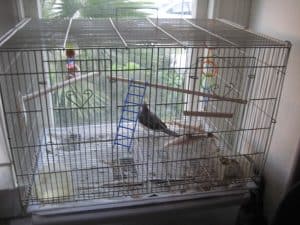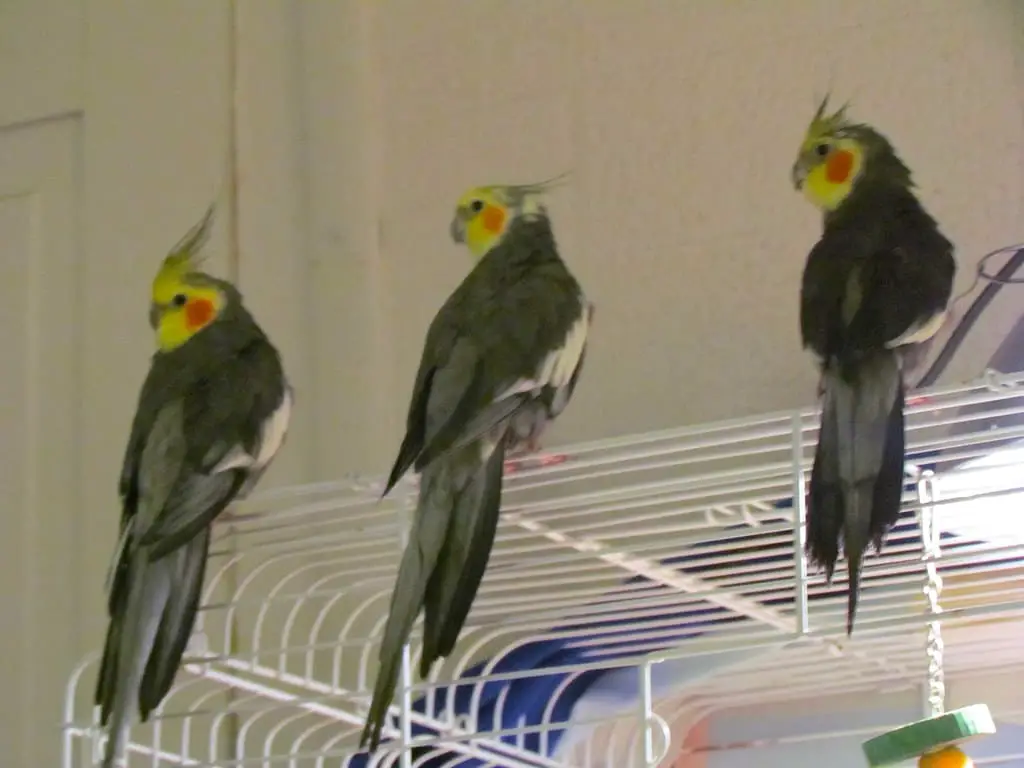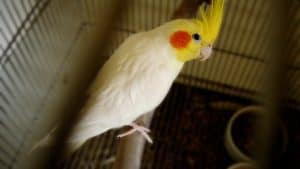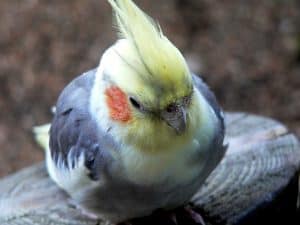Having a cockatiel as your feathered friend can be a delightful experience – they’re cute, playful, and absolutely full of personality. But getting your small bird back into its cage can sometimes be a challenging task. Especially if they’ve been happily flying around your room and don’t want the fun to end. However, there are some proven methods on how to get a cockatiel back into its cage. You need not worry, as we’ll share a few of these approaches that are sure to save you some time, and potential frustration with your feathered pal.
Cockatiels, like many other birds, are flock animals. They enjoy spending time with their human family members, exploring outside their cages, and making the most out of their playtime. Understanding this will make it easier for you when it’s time to get your bird back in its cage. The goal is to create an environment where your cockatiel sees its cage as a safe and fun place – somewhere it wants to be. This way, your bird tends to return to its cage voluntarily, willingly, and without fussing.
It’s important for bird owners to note that birds feel safe in familiar surroundings. So the cage becomes more than just a container – it’s their house. Your bird’s cage should be equipped with an array of toys, a food bowl, and comfortable perches. These simple steps can turn the sometimes tricky task of putting your small bird back in its cage, into an enjoyable routine for you and your cockatiel. Making sure to spend time inside the cage, playing with your bird, will also help build positive associations and encourage your cockatiel to return when playtime is over.
Understanding Your Cockatiel’s Behavior

Anyone who wonders how to get a cockatiel back into its cage must first seek to understand the bird’s behavior. This small bird, like most other bird species, is a flock animal by nature. For your feathered friend, this translates to a drive for social interaction and exploration outside of its cage. You’ll find that cage doors remain closed figuratively in the cockatiel’s mind because it wants to spend time with its “flock,” also known to bird owners as their human family.
The cage, which should be a safe and welcoming space for your parrot, can sometimes be seen as limiting by these sociable birds. This aversion can lead to resistance when it’s time to go back in. Understanding the bird’s perspective will make the process of placing it back in the cage less stressful for both you and your feathered companion.
Cockatiels, like many parrots, are more likely to enter their cage voluntarily if the process is associated with something positive and rewarding. Implementing strategies like positive reinforcement can greatly assist your efforts. A treat – something as simple as a chunk of apple or a spray of millet hung in the food bowl – can encourage your bird to move back into the cage willingly.
If your bird is new or not yet accustomed to its cage, it may take a few hours of patient interaction and slow conditioning using treats and gentle guidance to get your bird to enter the cage willingly. Remember, never force your bird back into the cage as this can create a negative connection to the cage for your bird and might increase its resistance to enter the cage in the future.
Cockatiels are clever small birds who love to play, so try using toys or even clicker training to make going back into the cage a fun game rather than a perceived punishment. A play stand near the cage with its door open can act as an inviting perch for your bird to sit and play while gradually getting used to being inside the cage.
Bird owners must remember, it’s not about forcing your cockatiel back in its cage, but rather teaching it to choose to go inside willingly. Understanding your bird’s behavior is crucial for this process.
Remember, patience is vital. And in the end, your bond with your cockatiel will be stronger due to the time and patience you invested in understanding its behavior.
- STURDY FRAME - This large birdcage is made of high-quality, low-carbon, rust-proof, and waterproof steel, with guaranteed quality and durability; Covered with non-toxic hammer-pattern paint, it gives birds a healthier and safer living environment; The steel frame is stable, with 4 caster wheels at the bottom, so you can move it anywhere you like, saving you effort; It has a perfect anti-escape design, and the latch is firm and safe
- CONSIDERATE DESIGN - Comes with a large interior space to make your pets enjoy the star-like treatment of a luxury villa; The flat-top gives more free spaces for you to hang various bird toys or to put some potted plants as decoration; Designed with a base frame for ample space of extra toys and room to play; A drawer-type sandbox and mesh shelf are added for convenience and accessibility
- EASY CLEANING - To clean the bottom of this birdcage, all you need to do is to slide out the bottom tray and wash it off; Additionally, all shelving can be easily removed for easy cleaning, so as to keep a clean and tidy environment as well as keep your pets safe
- SAFETY & SECURITY - Made of low-carbon steel, which is rust-proof and water-resistant, and the latches are strong and durable; 2-cage-doors design prevents your birds from escaping; Steel wires are evenly spaced to ensure safety and meet ornamental value at the same time
- ABUNDANT ACCESSORIES - In addition to high-quality steel cages, we also provide you with a wealth of accessories, including 4 white plastic food boxes, 3 long wooden sticks, and a colored bell stand
Methodical Steps to Get Your Cockatiel Back into Its Cage
As bird owners, you’ve probably faced the challenge of getting your feathered friend back in its cage. Here’s how you can make this process smooth and stress-free for both you and your cockatiel.
Cockatiels are flock animals. They also love exploring their surroundings, especially when they have the whole house to fly around. But when it’s time to go back in the cage, you might run into a bit of trouble. The most common issue faced by owners is getting the bird back into the cage after allowing it to spend time outside. However, with a systematic approach, you can teach your bird to return to its cage willingly.

Initially, try leaving the cage door open. Many small birds, like cockatiels, will go back to their cages voluntarily after they’ve had their fill of fun. If your bird has a favorite food or toy, place it inside the cage as a form of positive reinforcement. For instance, a spray millet in the food bowl or their favorite perch placed inside could coax them back.
Another practice is to encourage your bird to spend time inside the cage while having the door open. Over time, this helps normalize the cage as a safe and fun space, instead of confinement. Create an inviting environment inside the cage by adding toys and changing them frequently to maintain your bird’s interest.
You can also adapt the “Obedience Training Method” for cockatiels. This involves using a treat to lure your bird back into the cage, employing a little bit of trickery. Hold a treat in one hand and place it just inside the cage door. As your bird goes in to claim the treat, gently shut the door behind it. Over time, your cockatiel will associate this action with getting a treat and will most likely return to the cage willingly.
If your cockatiel refuses to go back, a last resort is to guide it with your hand very gently, avoiding any fast movements that could scare your bird. Get your bird to step onto your finger and then transfer it onto the perch inside the cage. Your tone and behavior play a pivotal role here as birds can sense stress or frustration. So, keep calm, maintain a steady pace, and be patient.
Remember, getting your cockatiel back into its cage doesn’t have to be a daunting task. With the right techniques and a bit of patience, your feathered friend will learn to return to the cage willingly and without prompting. It’s all about creating a positive association and making the cage an enticing place to be. With these methodical steps and tips, you’ll be well on your way to streamlining the process.
Final Thoughts: How to Get a Cockatiel Back into Its Cage

In conclusion, getting your cockatiel back into its cage can be a simple and stress-free process when approached with understanding and patience. By creating a safe and fun environment within the cage and understand your bird’s nature as a flock animal that yearns for social interaction, you can create positive associations for the cage. Using positive reinforcements, such as treats or favorite toys, obedience training, and slowly conditioning can all help your bird voluntarily return to its cage. Remember, it’s about enticing your feathered friend back with positivity and rewards, not force. With these methodologies and patience, your bond with your cockatiel stands to grow stronger.
Other suggested articles:




